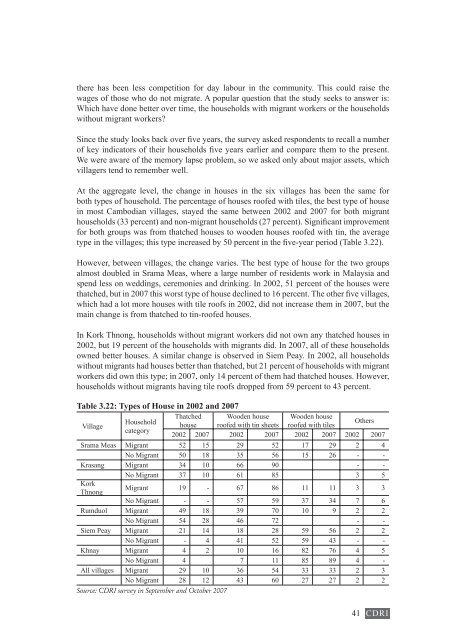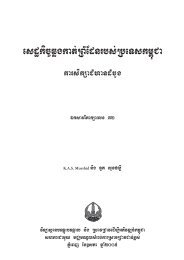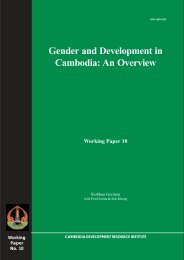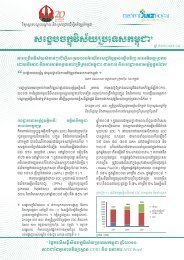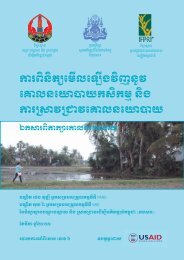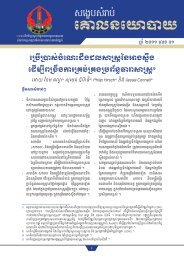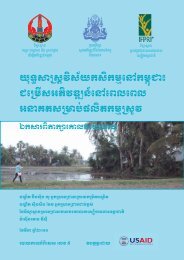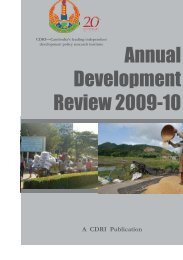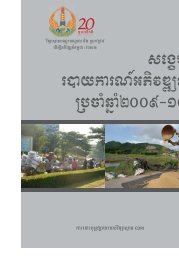Cambodia Country Study Working Paper Series No. 44 ... - CDRI
Cambodia Country Study Working Paper Series No. 44 ... - CDRI
Cambodia Country Study Working Paper Series No. 44 ... - CDRI
Create successful ePaper yourself
Turn your PDF publications into a flip-book with our unique Google optimized e-Paper software.
there has been less competition for day labour in the community. This could raise the<br />
�����������������������������������������������������������������������������������������<br />
Which have done better over time, the households with migrant workers or the households<br />
without migrant workers?<br />
�������������������������������������������������������������������������������������������<br />
�����������������������������������������������������������������������������������������<br />
��������������������������������������������������������������������������������������<br />
villagers tend to remember well.<br />
At the aggregate level, the change in houses in the six villages has been the same for<br />
both types of household. The percentage of houses roofed with tiles, the best type of house<br />
in most <strong>Cambodia</strong>n villages, stayed the same between 2002 and 2007 for both migrant<br />
����������������������������������������������������������������������������������������<br />
for both groups was from thatched houses to wooden houses roofed with tin, the average<br />
��������������������������������������������������������������������������������������������<br />
However, between villages, the change varies. The best type of house for the two groups<br />
�������������������������������������������������������������������������������������<br />
spend less on weddings, ceremonies and drinking. In 2002, 51 percent of the houses were<br />
�����������������������������������������������������������������������������������������������<br />
which had a lot more houses with tile roofs in 2002, did not increase them in 2007, but the<br />
main change is from thatched to tin-roofed houses.<br />
In Kork Thnong, households without migrant workers did not own any thatched houses in<br />
2002, but 19 percent of the households with migrants did. In 2007, all of these households<br />
owned better houses. A similar change is observed in Siem Peay. In 2002, all households<br />
without migrants had houses better than thatched, but 21 percent of households with migrant<br />
workers did own this type; in 2007, only 14 percent of them had thatched houses. However,<br />
households without migrants having tile roofs dropped from 59 percent to 43 percent.<br />
�������������������������������������������<br />
Village<br />
Household<br />
category<br />
Thatched<br />
house<br />
2002 2007<br />
Wooden house<br />
roofed with tin sheets<br />
2002 2007<br />
Wooden house<br />
roofed with tiles<br />
2002 2007<br />
Others<br />
2002 2007<br />
���������� ������� 52 15 29 52 17 29 2 4<br />
���������� 50 18 35 56 15 26 - -<br />
Krasang ������� 34 10 66 90 - -<br />
���������� 37 10 61 85 3 5<br />
Kork<br />
Thnong<br />
������� 19 - 67 86 11 11 3 3<br />
���������� - - 57 59 37 34 7 6<br />
Rumduol ������� 49 18 39 70 10 9 2 2<br />
���������� 54 28 46 72 - -<br />
Siem Peay ������� 21 14 18 28 59 56 2 2<br />
���������� - 4 41 52 59 43 - -<br />
Khnay ������� 4 2 10 16 82 76 4 5<br />
���������� 4 7 11 85 89 4 -<br />
All villages ������� 29 10 36 54 33 33 2 3<br />
���������� 28 12 43 60 27 27 2 2<br />
Source: <strong>CDRI</strong> survey in September and October 2007<br />
41 <strong>CDRI</strong>


